Narrow-Linewidth 2 μm All-Fiber Laser Amplifier with a Highly Stable and Precisely Tunable Wavelength for Gas Molecule Absorption in Photonic Crystal Hollow-Core Fibers
Abstract
:1. Introduction
2. Experimental Setup
3. Experimental Results and Discussion
3.1. Seed Characteristics
3.2. The First-Stage Amplifier
3.3. The Second-Stage Amplifier
4. Conclusions
Author Contributions
Funding
Institutional Review Board Statement
Informed Consent Statement
Data Availability Statement
Conflicts of Interest
Sample Availability
References
- Wang, W.C.; Zhou, B.; Xu, S.H.; Yang, Z.M.; Zhang, Q.Y. Recent Advances in Soft Optical Glass Fiber and Fiber Lasers. Prog. Mater. Sci. 2019, 101, 90–171. [Google Scholar] [CrossRef]
- Henderson, S.W.; Hale, C.P.; Magee, J.R.; Huffaker, A.V. Eye-Safe Coherent Laser Radar System at 2.1 μm Using Tm, Ho:YAG Lasers. Opt. Lett. 1991, 16, 773–775. [Google Scholar] [CrossRef] [PubMed]
- Polder, K.D.; Bruce, S. Treatment of Melasma Using a Novel 1927 nm Fractional Thulium Fiber Laser: A Pilot Study. Derm. Surg. 2012, 38, 199–206. [Google Scholar] [CrossRef] [PubMed]
- Peterka, P.; Faure, B.; Blanc, W.; Karásek, M.; Dussardier, B. Theoretical Modelling of S-Band Thulium-Doped Silica Fibre Amplifiers. Opt. Quantum Electron. 2004, 36, 201–212. [Google Scholar] [CrossRef] [Green Version]
- Sincore, A.; Bradford, J.D.; Cook, J.; Shah, L.; Richardson, M.C. High Average Power Thulium-Doped Silica Fiber Lasers: Review of Systems and Concepts. IEEE J. Select. Topics Quantum Electron. 2018, 24, 1–8. [Google Scholar] [CrossRef]
- Li, J.; Sun, Z.; Luo, H.; Yan, Z.; Zhou, K.; Liu, Y.; Zhang, L. Wide Wavelength Selectable All-Fiber Thulium Doped Fiber Laser between 1925 nm and 2200 nm. Opt. Express 2014, 22, 5387. [Google Scholar] [CrossRef]
- Liu, J.; Shi, H.; Liu, K.; Hou, Y.; Wang, P. 210 W Single-Frequency, Single-Polarization, Thulium-Doped All-Fiber MOPA. Opt. Express 2014, 22, 13572. [Google Scholar] [CrossRef] [PubMed]
- Zhang, Q.; Hou, Y.; Wang, X.; Song, W.; Chen, X.; Bin, W.; Li, J.; Zhao, C.; Wang, P. 5 W Ultra-Low-Noise 2 μm Single-Frequency Fiber Laser for next-Generation Gravitational Wave Detectors. Opt. Lett. 2020, 45, 4911. [Google Scholar] [CrossRef] [PubMed]
- Gebhardt, M.; Gaida, C.; Kadwani, P.; Sincore, A.; Gehlich, N.; Jeon, C.; Shah, L.; Richardson, M. High Peak-Power Mid-Infrared ZnGeP2 Optical Parametric Oscillator Pumped by a Tm:Fiber Master Oscillator Power Amplifier System. Opt. Lett. 2014, 39, 1212. [Google Scholar] [CrossRef] [PubMed] [Green Version]
- Dalloz, N.; Robin, T.; Cadier, B.; Kieleck, C.; Eichhorn, M.; Hildenbrand-Dhollande, A. High Power Q-Switched Tm3+, Ho3+-Codoped 2 μm Fiber Laser and Application for Direct OPO Pumping. In Proceedings of the Fiber Lasers XVI: Technology and Systems, San Francisco, CA, USA, 4–7 February 2019; Dong, L., Carter, A.L., Eds.; SPIE: San Francisco, CA, USA, 7 March 2019; p. 18. [Google Scholar]
- Holmen, L.G.; Fonnum, H. Holmium-Doped Fiber Amplifier for Pumping a ZnGeP2 Optical Parametric Oscillator. Opt. Express 2021, 29, 8477. [Google Scholar] [CrossRef] [PubMed]
- Miller, H.C.; Radzykewycz, D.T.; Hager, G. An Optically Pumped Mid-Infrared HBr Laser. IEEE J. Quantum Electron. 1994, 30, 2395–2400. [Google Scholar] [CrossRef]
- McCord, J.E.; Miller, H.C.; Hager, G.; Lampson, A.I.; Crowell, P.G. Experimental Investigation of an Optically Pumped Mid-Infrared Carbon Monoxide Laser. IEEE J. Quantum Electron. 1999, 35, 1602–1612. [Google Scholar] [CrossRef]
- Aghbolagh, F.B.A.; Nampoothiri, V.; Debord, B.; Gerome, F.; Vincetti, L.; Benabid, F.; Rudolph, W. Mid IR Hollow Core Fiber Gas Laser Emitting at 4.6 μm. Opt. Lett. 2019, 44, 383. [Google Scholar] [CrossRef] [PubMed]
- Cui, Y.; Huang, W.; Wang, Z.; Wang, M.; Zhou, Z.; Li, Z.; Gao, S.; Wang, Y.; Wang, P. 4.3 μm Fiber Laser in CO2-Filled Hollow-Core Silica Fibers. Optica 2019, 6, 951. [Google Scholar] [CrossRef]
- Zhou, Z.; Li, H.; Cui, Y.; Huang, W.; Wang, Z. Optically Pumped 4 μm CW HBr Gas Laser Based on Hollow-Core Fiber. Acta Opt. Sin. 2020, 40, 1614001. [Google Scholar] [CrossRef]
- Meleshkevich, M.; Platonov, N.; Gapontsev, D.; Drozhzhin, A.; Sergeev, V.; Gapontsev, V. 415 W Single-Mode CW Thulium Fiber Laser in All-Fiber Format. In Proceedings of the 2007 European Conference on Lasers and Electro-Optics and the International Quantum Electronics Conference, Munich, Germany, 17–22 June 2007; IEEE: Munich, Germany, 2007; p. 1. [Google Scholar]
- Tang, Y.; Huang, C.; Wang, S.; Li, H.; Xu, J. High-Power Narrow-Bandwidth Thulium Fiber Laser with an All-Fiber Cavity. Opt. Express 2012, 20, 17539. [Google Scholar] [CrossRef] [PubMed]
- Wang, X.; Jin, X.; Wu, W.; Zhou, P.; Wang, X.; Xiao, H.; Liu, Z. 310-W Single Frequency Tm-Doped All-Fiber MOPA. IEEE Photon. Technol. Lett. 2015, 27, 677–680. [Google Scholar] [CrossRef]
- Guan, X.; Yang, C.; Lin, W.; Zhao, Q.; Tan, T.; Gu, Q.; Zhou, K.; Wei, X.; Yang, Z.; Xu, S. Intensity-Noise Suppression in 1950-Nm Single-Frequency Fiber Laser by Bidirectional Amplifier Configuration. Opt. Lett. 2020, 45, 5484. [Google Scholar] [CrossRef] [PubMed]
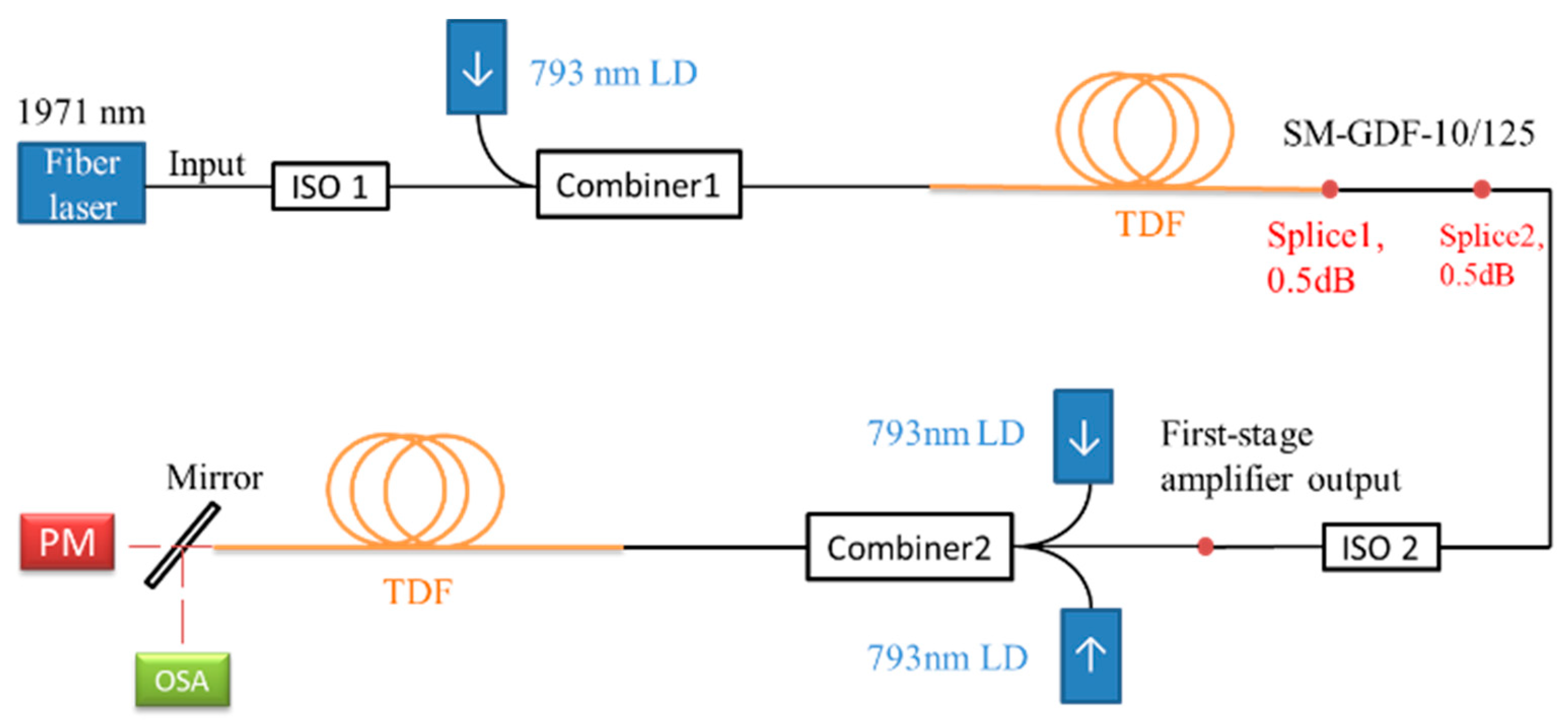
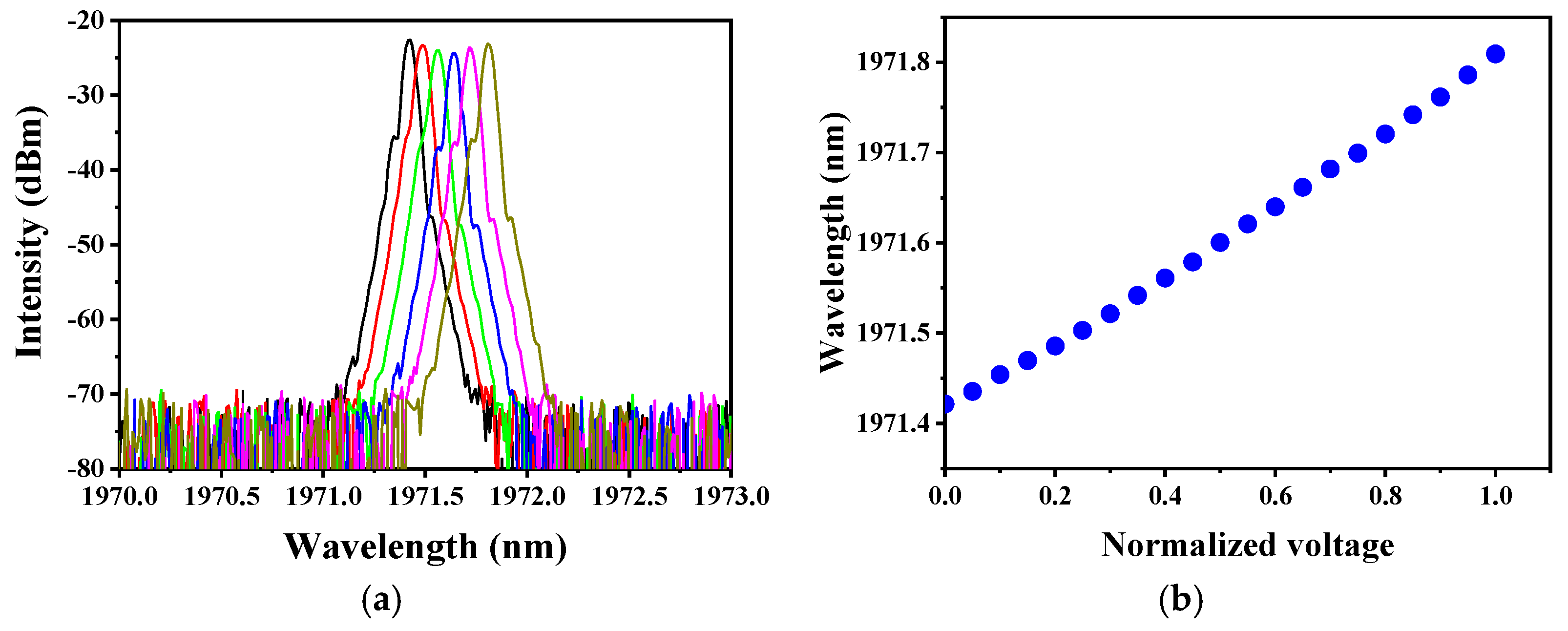
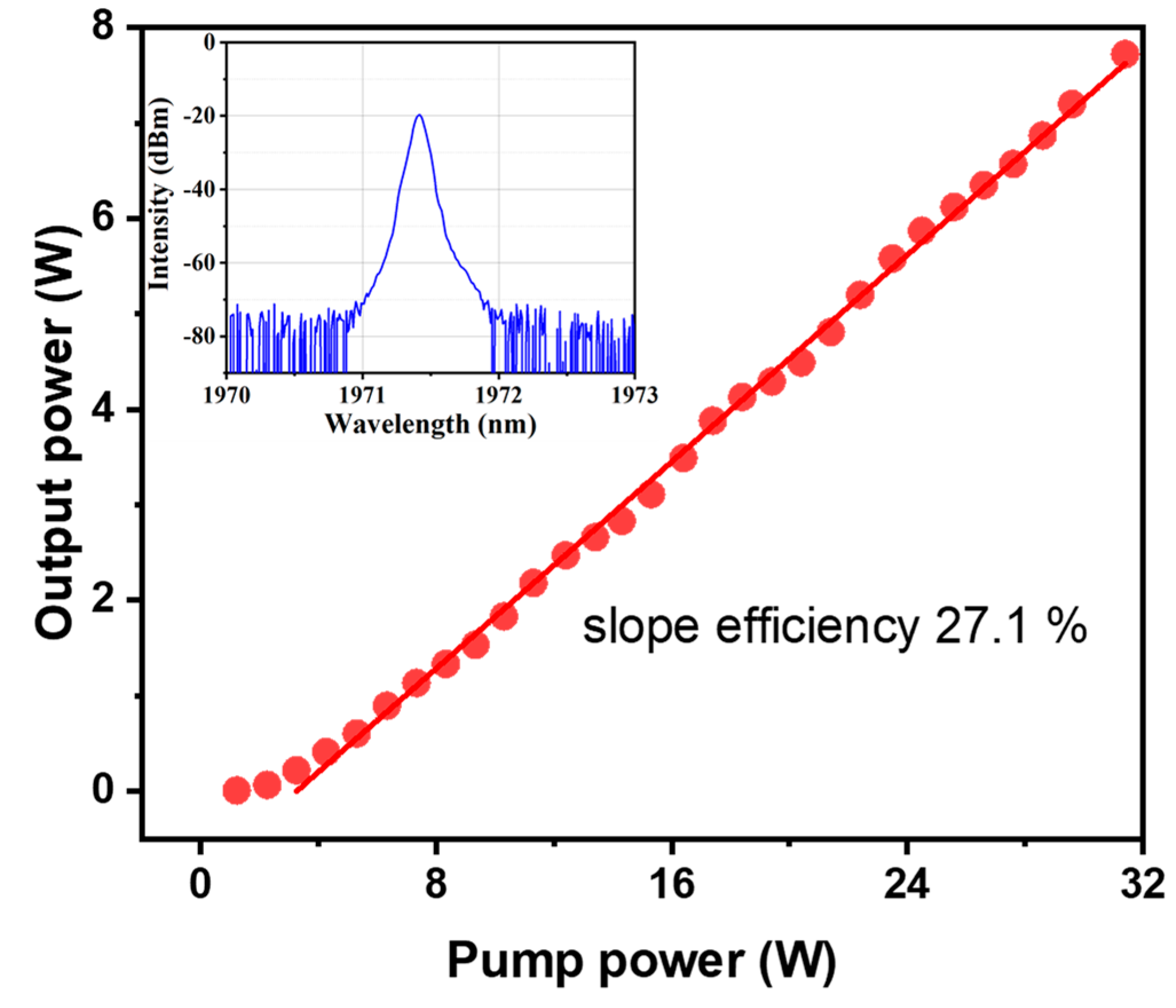
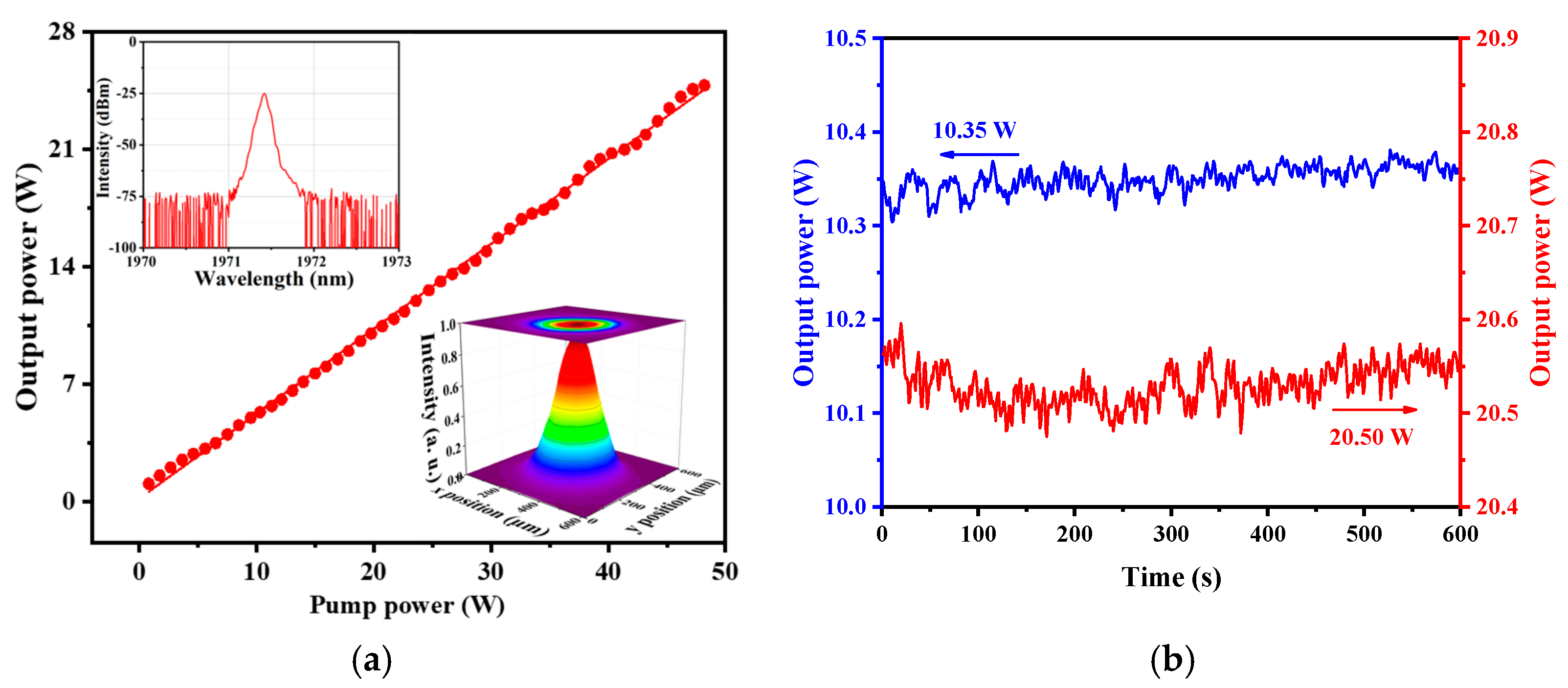
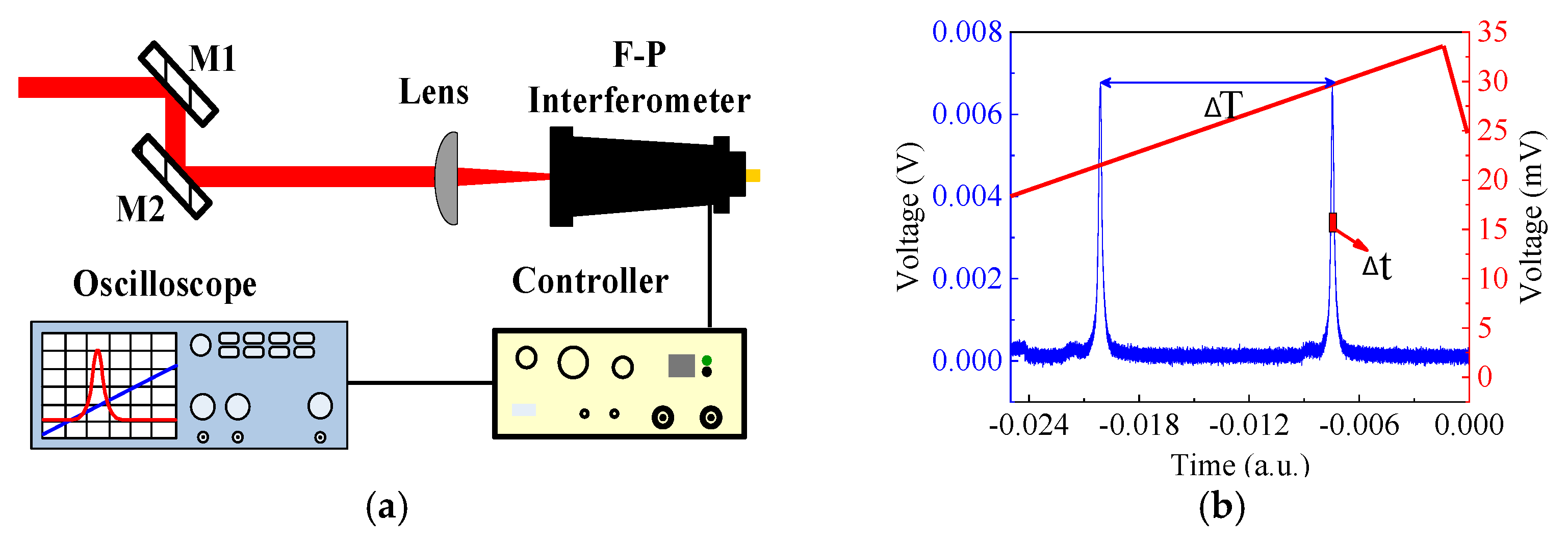
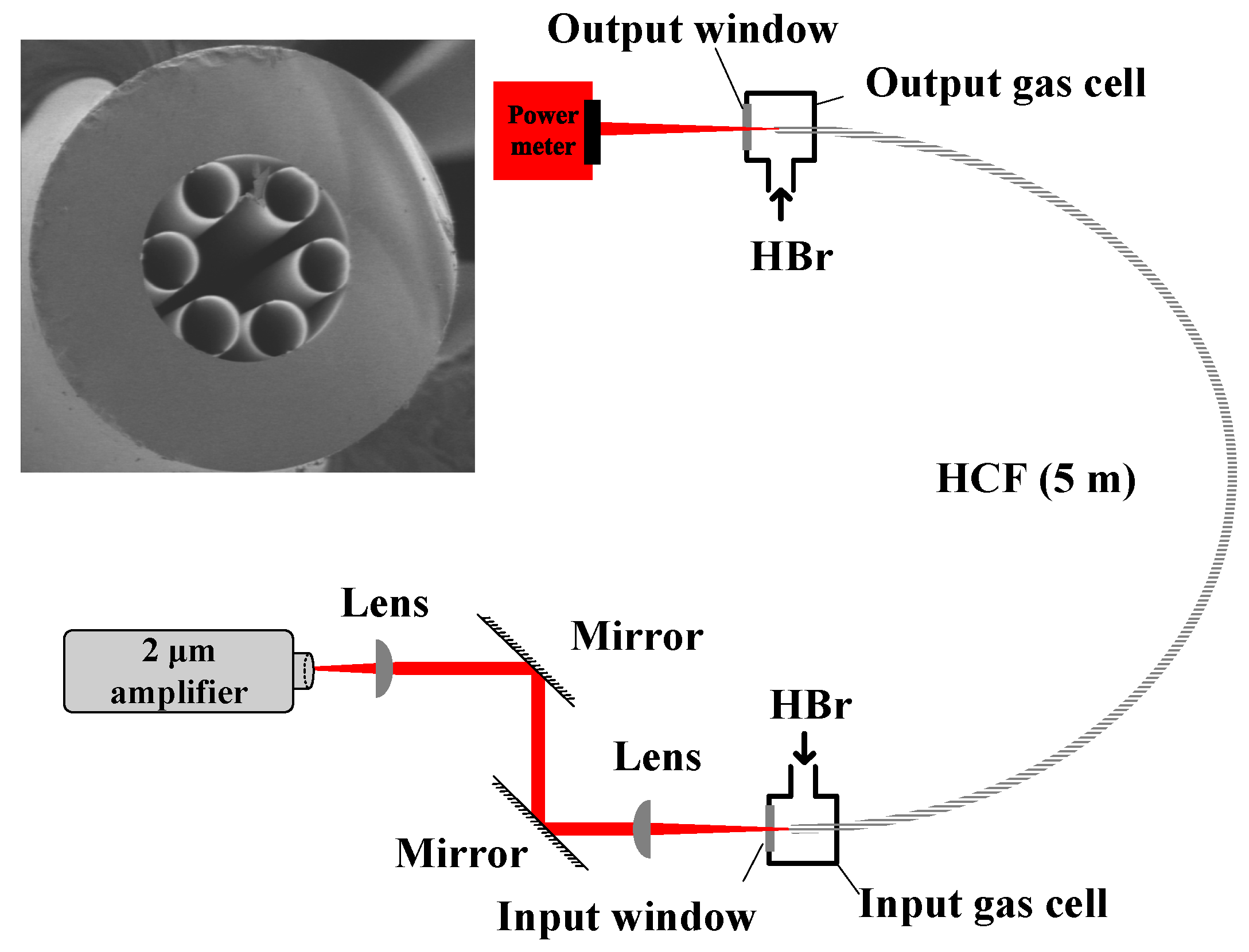
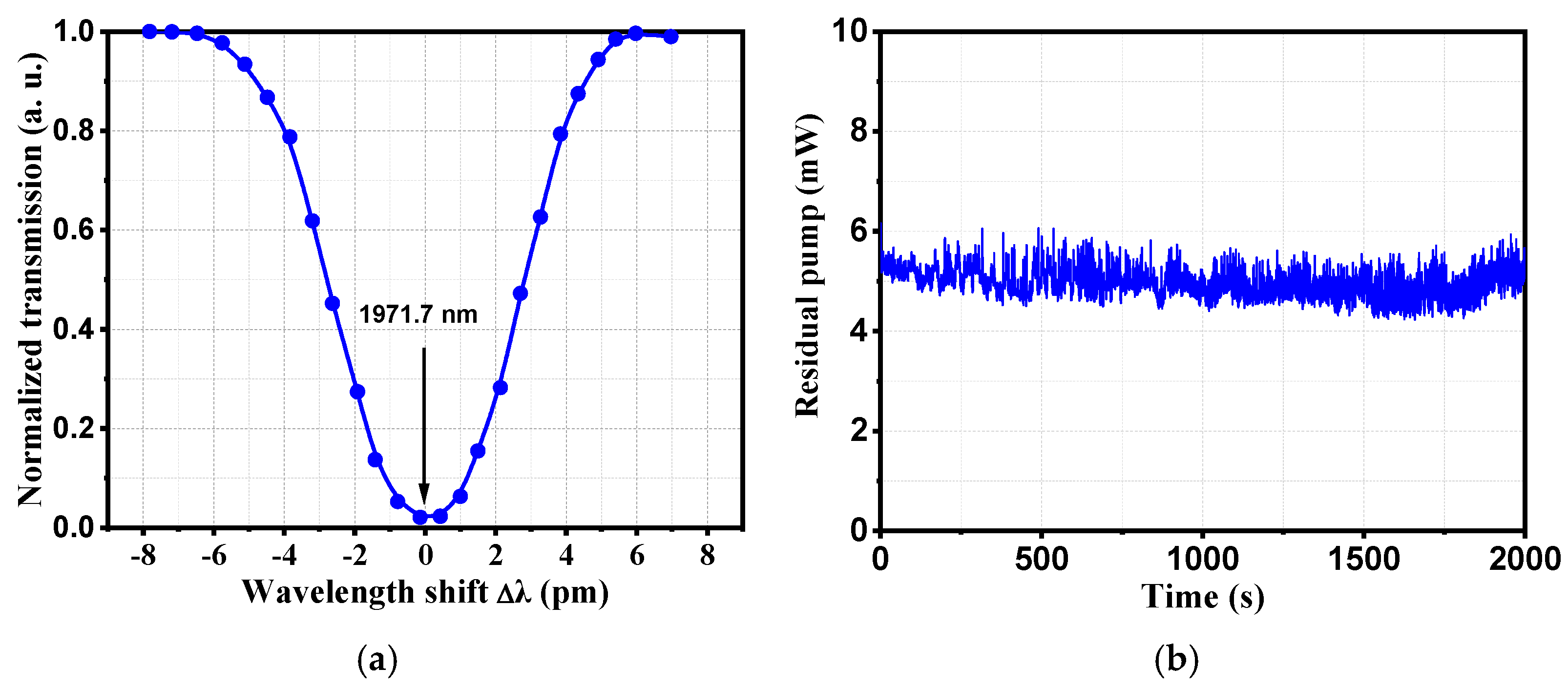
| Power (W) | ΔT (ms) | Δt (μs) | Linewidth (MHz) |
|---|---|---|---|
| 1 | 15.18 | 66 | 6.48 |
| 5 | 15.16 | 74 | 7.26 |
| 10 | 15.20 | 70 | 6.87 |
| 20 | 15.24 | 72 | 7.07 |
Publisher’s Note: MDPI stays neutral with regard to jurisdictional claims in published maps and institutional affiliations. |
© 2021 by the authors. Licensee MDPI, Basel, Switzerland. This article is an open access article distributed under the terms and conditions of the Creative Commons Attribution (CC BY) license (https://creativecommons.org/licenses/by/4.0/).
Share and Cite
Pei, W.; Li, H.; Cui, Y.; Zhou, Z.; Wang, M.; Wang, Z. Narrow-Linewidth 2 μm All-Fiber Laser Amplifier with a Highly Stable and Precisely Tunable Wavelength for Gas Molecule Absorption in Photonic Crystal Hollow-Core Fibers. Molecules 2021, 26, 5323. https://doi.org/10.3390/molecules26175323
Pei W, Li H, Cui Y, Zhou Z, Wang M, Wang Z. Narrow-Linewidth 2 μm All-Fiber Laser Amplifier with a Highly Stable and Precisely Tunable Wavelength for Gas Molecule Absorption in Photonic Crystal Hollow-Core Fibers. Molecules. 2021; 26(17):5323. https://doi.org/10.3390/molecules26175323
Chicago/Turabian StylePei, Wenxi, Hao Li, Yulong Cui, Zhiyue Zhou, Meng Wang, and Zefeng Wang. 2021. "Narrow-Linewidth 2 μm All-Fiber Laser Amplifier with a Highly Stable and Precisely Tunable Wavelength for Gas Molecule Absorption in Photonic Crystal Hollow-Core Fibers" Molecules 26, no. 17: 5323. https://doi.org/10.3390/molecules26175323
APA StylePei, W., Li, H., Cui, Y., Zhou, Z., Wang, M., & Wang, Z. (2021). Narrow-Linewidth 2 μm All-Fiber Laser Amplifier with a Highly Stable and Precisely Tunable Wavelength for Gas Molecule Absorption in Photonic Crystal Hollow-Core Fibers. Molecules, 26(17), 5323. https://doi.org/10.3390/molecules26175323





